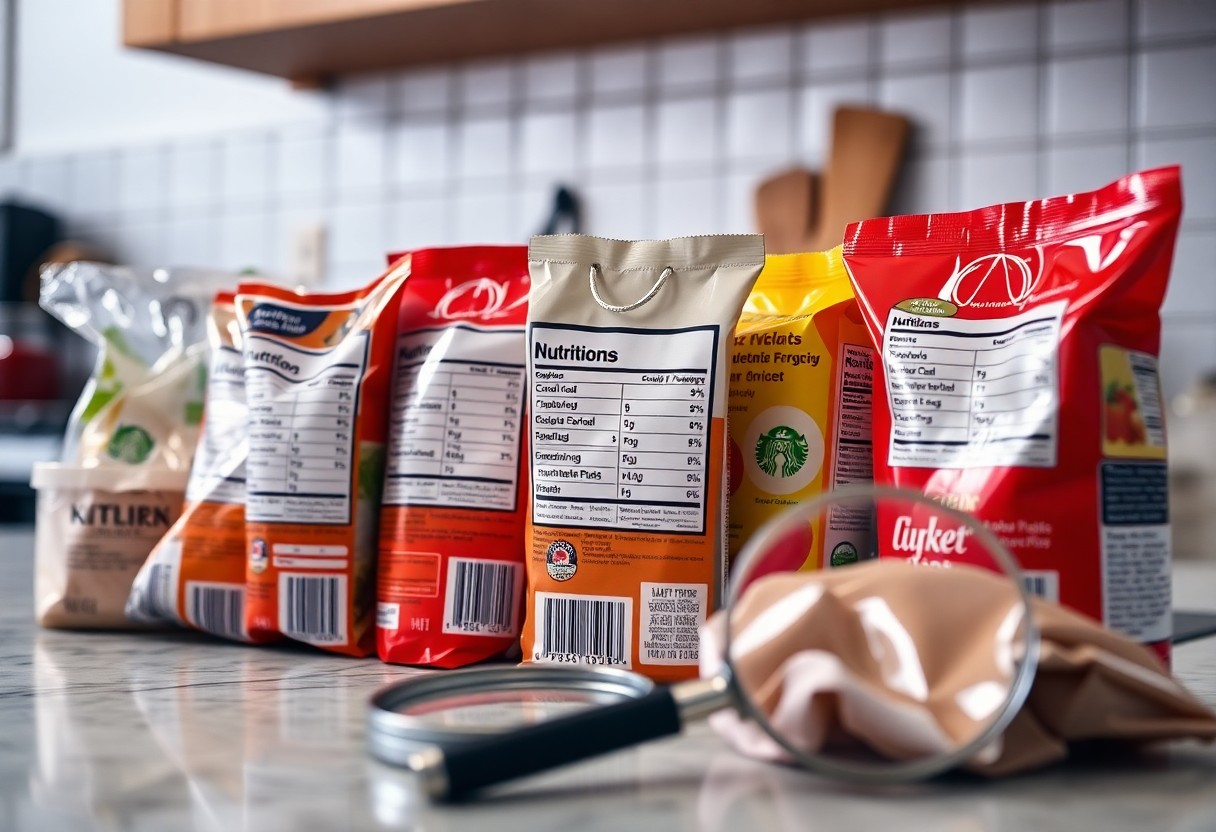You have the power to make informed food choices by understanding how to read food labels effectively. Learn to decipher the ingredients list to identify potential allergens or additives that may not be beneficial for your health. Discover the true meanings behind terms like “organic,” “natural,” and “low-fat” to avoid being misled. With this guide, you will be equipped to navigate nutrition facts and make choices that align with your dietary goals.
Understanding Food Labels
Deciphering food labels allows you to make better dietary choices. You can gain insights into vital information such as ingredients, nutritional values, and claims like “organic” or “natural.” This understanding empowers you to select foods that align with your health goals and dietary preferences.
Types of Food Labels
Food labels can be broadly categorized into several types, each serving a different purpose and providing distinct information.
- Nutritional labels: Present calorie counts and nutrient breakdowns.
- Ingredient lists: Detail all components in the product.
- Nutrient claims: Statements about specific health-related benefits.
- Allergen warnings: Indicate potential allergens present.
- Certification labels: Communicate organic or fair-trade status.
After understanding these categories, you can approach food choices with more confidence.
| Label Type | Description |
| Nutritional labels | Provide detailed information on calories and nutrients. |
| Ingredient lists | List all ingredients in descending order by weight. |
| Nutrient claims | Offer health-related benefits, like “low-fat” or “sugar-free.” |
| Allergen warnings | Warn about common allergens present in the food. |
| Certification labels | Indicate organic, non-GMO, or humane treatment standards. |
Key Components of Food Labels
Essential components of food labels include serving size, calories, macronutrients, vitamins, minerals, and ingredient lists. Each plays a significant role in helping you evaluate a product’s nutritional value.
Serving size is foundational as it dictates the nutritional information provided. Calories reveal the energy content, while macronutrients like fats, carbs, and proteins help assess your dietary balance. Additionally, vitamins and minerals are crucial for understanding the micronutritional benefits. Ingredient lists, in contrast, disclose what’s actually in the product, clarifying hidden additives and preservatives. You can make informed dietary choices when you analyze these components thoroughly.
Step-by-Step Guide to Reading Labels
Reading food labels effectively involves a systematic approach. Start by checking the serving size at the top of the label, as it sets the basis for the nutritional values listed. Next, analyze the calories per serving and how it fits into your daily caloric intake. After that, review the nutritional information such as fats, carbohydrates, and proteins. For more detailed guidance, refer to How to Read Nutrition Labels: A Guide to Smarter Food …
Analyzing Serving Sizes
Analyzing Serving Sizes
Serving sizes dictate the amounts of nutrients and calories in a food product. Always compare the serving size with the quantity you consume. For instance, a bag of chips may list a serving size as 1 ounce, but you might eat 3 ounces. This discrepancy could mean you’re consuming three times the calories and fat, so adjusting your portion is necessary for maintaining your dietary goals.
Interpreting Nutritional Information
Interpreting Nutritional Information
Nutritional information details the macronutrients and micronutrients in your food. Understanding these values allows you to assess whether a food supports your dietary needs or goals. Pay close attention to saturated fats, sugars, and sodium. Excessive amounts of these can lead to health issues like heart disease or diabetes, making it vital to choose foods low in these components.
To further interpret nutritional information, focus on specific ingredients that denote quality. For example, whole grains are beneficial; however, terms like “enriched” or “refined” suggest a loss of nutrients. Additionally, while “natural” and “organic” labels sound appealing, they can be misleading. Always scrutinize the ingredient list; ingredients should be recognizable and minimal. This awareness equips you to make healthier decisions that align with your health objectives.

Tips for Making Informed Choices
Harness your knowledge of food labels to enhance your grocery shopping experience. Focus on these practices:
- Examine the nutrition facts for serving sizes and calories.
- Identify ingredients by looking for whole foods and avoiding artificial additives.
- Understand health claims like “organic” and “low-fat” and what they truly signify.
- Opt for products with fewer than five ingredients.
After you apply these tips, your selections will more closely align with your health goals.
Identifying Health Claims
Assessing health claims on labels can guide your purchases. Claims such as “organic” signify adherence to specific agricultural standards, while “natural” may not have a strict definition. Understanding these terms empowers you to choose foods that fit your values and health needs.
Recognizing Misleading Labels
Be vigilant regarding misleading labels that can skew your perceptions of a product’s healthiness. Terms like “sugar-free” might be accompanied by artificial sweeteners, skewing nutritional balance. Knowing how to decipher these terms helps in making choices that support your overall health.
Products can be marketed with labels that sound beneficial but may not convey the full story. A beverage labeled “low-calorie” could still contain high levels of sodium or other unhealthy additives. Checking the ingredient list reveals the underlying truth, ensuring you avoid products that masquerade as healthy without the substance to back it up.

Factors to Consider When Purchasing
Evaluate labeling elements to enhance your food choices effectively. Focus on the following:
- Ingredient lists
- Nutritional information
- Serving sizes
- Manufacturing claims
- Allergen alerts
Any choices you make should align with your dietary needs and preferences, ensuring you prioritize quality and healthfulness.
Ingredient Lists
Ingredient lists provide valuable insights into what’s in your food. Ingredients are listed in descending order by weight, meaning the first few items represent the bulk of the product. Look for recognizable, whole foods, and be cautious of products with long lists that include preservatives, artificial flavors, or excessive sugar.
Allergen Information
Allergen information is critical for those with food sensitivities. Labels often highlight common allergens such as nuts, dairy, wheat, and soy. These alerts help you avoid potentially harmful reactions, especially in packaged foods where cross-contamination is a risk.
Manufacturers are required to clearly identify allergens within the ingredient list or in a separate allergen statement. For example, if a product contains peanuts, it needs to be explicitly stated, usually in bold. You should always check for specific phrases like “may contain” or “produced in a facility that processes” to gauge risk levels. Scanning labels for allergen information is vital for maintaining safety and ensuring a worry-free diet.

Pros and Cons of Organic and Natural Labels
Pros and Cons of Organic and Natural Labels
| Pros | Cons |
|---|---|
| Fewer synthetic pesticides | Higher price point |
| Improved soil health | Limited availability |
| Supports biodiversity | Claims can be vague |
| Potentially better taste | Organic does not mean free of all chemicals |
| Animal welfare standards | Not all organic brands are equal |
Benefits of Organic Products
Organic products often contain fewer harmful chemicals and synthetic substances, promoting health benefits. These foods are typically fresher, as they don’t have preservatives that prolong shelf life. You may also find that organic farming practices support better environmental stewardship, contributing to sustainable agriculture and reducing pollution and soil degradation.
Considerations with Natural Claims
Natural labels can often mislead, as there is no standardized definition enforced by the FDA. Products labeled “natural” can still contain additives or preservatives. It’s crucial to scrutinize these claims and verify them with ingredient lists and nutrition facts. For example, a product might be marketed as natural but still contain high levels of sugars or unhealthy fats.
Evaluating natural claims requires diligence. While natural ingredients often suggest a healthier option, these labels can be exploited by manufacturers looking to appeal to health-conscious consumers. Many products labeled as “natural” may still include processed elements, artificial flavorings, or sugars that counteract any perceived health benefits. Always check the ingredient list for clarity and alignment with your dietary goals. For deeper insights into reading food labels, consult resources like How To Read Food and Beverage Labels.
Common Labeling Myths
Many consumers fall for labeling myths that lead to misguided food choices. For instance, the term “natural” isn’t strictly defined, so products bearing this label can still contain preservatives or added sugars. Similarly, “low-fat” doesn’t always signify healthier options, as these foods may be loaded with sugars to enhance flavor. Challenges in deciphering labels intensify when fads influence perceptions, causing you to overlook imperative nutrient information.
Debunking Popular Misconceptions
Misconceptions surrounding food labels can skew your understanding of nutrition. For instance, “organic” doesn’t guarantee a lower calorie count but often implies reduced pesticide use. Moreover, products that claim to be “sugar-free” can still contain artificial sweeteners, which may not align with personal health goals. Understanding these nuances helps you make more informed choices.
The Impact of Marketing on Consumer Choices
Marketing tactics significantly shape consumer decisions, often overshadowing factual information. Eye-catching claims on packaging can divert your attention from actual ingredient lists and nutrition facts, leading to potentially unhealthy choices. Advertisements frequently highlight selective attributes, like “gluten-free” or “fortified,” while concealing undesirable ingredients such as high levels of sodium or artificial additives. Consequently, you might prioritize marketed benefits over overall nutritional value.
Advertising techniques manipulate perceptions, emphasizing certain aspects while downplaying others. For instance, a snack labeled “low-calorie” may attract your interest, yet it could be high in additives or loaded with sugar substitutes that aren’t conducive to well-being. Studies show that over 50% of consumers rely on labels to gauge product healthiness, demonstrating the alarming influence of marketing. Being aware of these tactics empowers you to sift through persuasive language and focus on what truly matters in nutrition, enabling healthier choices during your shopping journey.
Conclusion
The ultimate guide to reading food labels empowers you to make informed dietary choices by understanding ingredients, nutrition facts, and terms like “organic,” “natural,” and “low-fat.” By applying this knowledge, you can better navigate your food options to suit your health needs. For more detailed insights, refer to A Guide to Reading Food Labels, which offers practical tips to enhance your reading skills and promote healthier eating habits.
FAQ
Q: What are the key components of a food label?
A: A food label typically includes the product name, serving size, calories, nutrition facts (such as fats, carbohydrates, proteins, vitamins, and minerals), ingredient list, and claims (like organic or low-fat).
Q: How can I interpret the ingredient list on a food label?
A: Ingredients are listed in descending order by weight. The first few ingredients make up the majority of the product, so look for whole foods and avoid those with many additives or artificial substances.
Q: What does “organic” mean on food labels?
A: “Organic” means the product is made from ingredients produced without synthetic pesticides, fertilizers, or genetically modified organisms. Look for certification seals for verification.
Q: How do I know if a product is truly “low-fat”?
A: “Low-fat” refers to products containing 3 grams of fat or less per serving. Always check the nutrition facts label to ensure it aligns with this standard and to understand overall caloric content.
Q: What should I consider when a product claims to be “natural”?
A: The term “natural” is not strictly regulated, which means it can vary between products. Look for other certifications and verify ingredient lists to ascertain the product’s true nature.